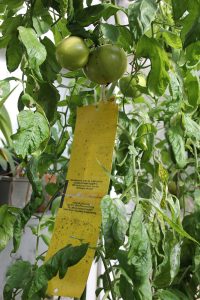A while ago a gardener asked me what my greenhouse’s greatest insect problem was. I answered whitefly, which is a terrible nuisance that can easily get out of control. That conversation got me thinking about the Sisyphean task of trying to eliminate my whitefly infestation by spraying infected plants with Safer’s Insecticidal Soap. The more I sprayed (and coughed) the more whiteflies there seemed to be. I therefore decided to try a different approach – the biological control or insect pests, often called biocontrol for short. This is the control of invasive insect species by introducing natural predators where those predators are currently lacking. My greenhouse was clearly a prime example of a place where whiteflies had no natural enemies.

So I purchased a thousand Encarsia formosa wasps, known to be a deadly parasite of whitefly, and released them in my greenhouse. Soon the whitefly disappeared through a natural process of predation. The females of this small wasp species feed on the blood of whiteflies in their immature stages and also deposit their eggs in them. When the wasp eggs hatch into larvae, the larvae feed on the immature whiteflies from within, eventually killing them.
To make a rough estimate of how extensive a whitefly problem you have, simply install a few yellow sticky cards inside your greenhouse and observe how many whiteflies they trap. But be sure not to put the cards in walkways where you may bump into them. Getting the sticky residue out of your hair can be a problem, not to mention how yucky it is when dead insects are attached to it. On this matter, I speak from experience!
I’ve had similar luck using biocontrol to rid my greenhouse of an aphid infestation, this time with ladybugs being the predators. I bought 3,000 ladybugs – the smallest number I could find for sale – and released them in the greenhouse. They cleared out the aphids quickly, which is not surprising since an adult ladybug can eat 50 or more aphids a day. However, as soon as I opened the windows in spring, the ladybugs flew away. That, too, is not surprising because the bountiful buffet of aphids had by then been devoured. Ladybugs are not apt to lay eggs on the plants they’re released onto, so don’t expect the supply of ladybugs to be self-sustaining. I think I saw maybe six ladybugs in my greenhouse the following winter.

Note, too, that releasing biological controls into your greenhouse must be done at the right time to affect the target pest. For example, your greenhouse should be around 75-85°F for Encarsia formosa wasps to be effective on whitefly. If it is too cold or too hot, the wasps may stay dormant while your whiteflies spread. You also need to remember not to use any fungicides or insecticides in your greenhouse for at least a week prior to releasing predatory insects, and for two or three weeks while these insects are doing their job.
Plant-eating thrips are more difficult to eliminate from a greenhouse using biological control, but introducing a natural predator can nevertheless be helpful. Because thrips are tiny – only a 1/16th of an inch (0.5mm) or even smaller – they can be difficult to spot before they do extensive damage. To find our if your plants have thrips, put wax paper or plain white paper under the plant and shake it. If thrips are present, some of these little insects will fall off onto the paper. Rove beetles (Dalotia coriaria, formerly called Atheta coriaria) are one potential biological control for thrips. These predatory beetles typically inhabit the top layer of soil in which the plants grow, where they may feed on thrip pupae. However, temperature and humidity play a large part in their effectiveness in controlling thrips. For a small greenhouse, other methods of ridding plants of thrips include blasting them with a garden hose, washing them with soap and water, or spraying them with plant-derived insect deterrents, such as neem oil or pyrethrin.
The use of natural predators as biological controls for a variety of insect pests has become very popular in large commercial greenhouses. These natural predators are seen as a desirable alternative to dependence on toxic pesticides. Biological control laboratories, such as the one at the University of Rhode Island, play an important role in researching which species of predators are most effective in eliminating which problematic insects and how those predators can best be deployed. We greenhouse gardeners can read about this research and reap the benefits of it.


